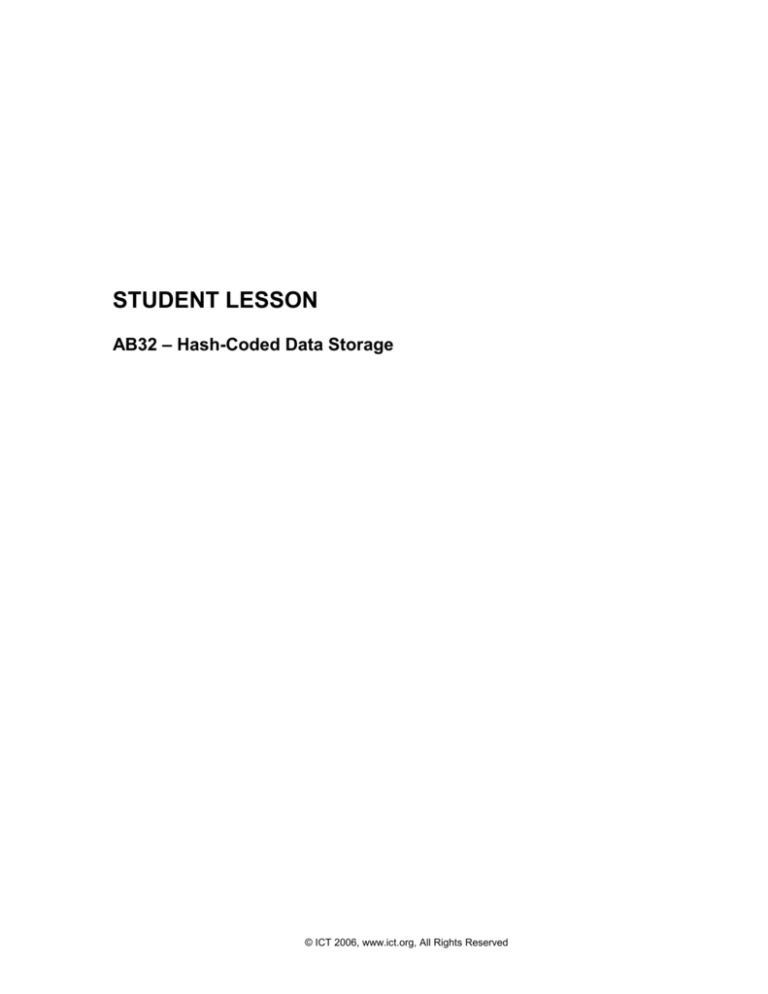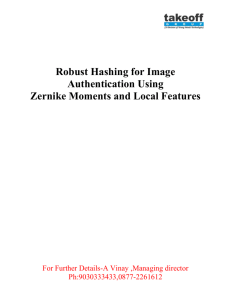
STUDENT LESSON
AB32 – Hash-Coded Data Storage
© ICT 2006, www.ict.org, All Rights Reserved
1
Java Curriculum for AP Computer Science, Student Lesson AB32
STUDENT LESSON
AB32 – Hash-Coded Data Storage
INTRODUCTION:
In the labs in previous lessons, you have searched a data file containing ID
and inventory information in a variety of ways. Of the search algorithms
studied, the fastest search algorithm was O(log2N) for a binary tree or binary
search of an ordered array. It is possible to improve on these algorithms,
reducing the order of searching to O(1). The data structure used to
accomplish this is called a hash table, and the O(1) search is referred to as
hashing.
An example of hashing frequently occurs in schools, when students line up
into 26 lines, each line representing the first letter of their last name. Another
example occurs when one large group or list of student schedules is broken
down into smaller groupings or lists, often by grade level, for easier
distribution. This is what hash-coded data storage is about - breaking up and
reorganizing one big list into many smaller lists.
The key topics for this lesson are:
A.
B.
C.
D.
Hashing Schemes
Dealing with Collisions
Order of a Hash-Coded Data Search
HashSet and HashMap
VOCABULARY:
COLLISIONS
HASH KEY
DISCUSSION:
A. Hashing Schemes
HASHING
HASH TABLE
1. The example of distributing student schedules illustrates a natural means
of hashing. The process can be simplified even further by organizing the
schedules into piles by the first letter of the last name.
2. A hashing scheme involves converting a key piece of information into a
specific location, thus reducing the amount of searching in the data
structure. Instead of working with the entire list or tree of data, the
hashing scheme tells you exactly where to store that data or search for it.
© ICT 2006, www.ict.org, All Rights Reserved
Use permitted only by licensees in accordance with license terms (http://www.ict.org/javalicense.pdf)
2
Java Curriculum for AP Computer Science, Student Lesson AB32
3. One important bar code system used by retail stores is the UPC A code1,
which involves a sequence of 10 digits. This system provides for 10 billion
different possible products, 0 - 9,999,999,999 (which equals 1010 – 1). For
quick access, an array of 10 billion locations would be nice, but wasteful in
terms of computer memory. Since it is unlikely that a store would carry
such a huge number of items, a system is needed to store a list of products
in a reasonably sized array.
4. A cash register using a bar code scanner needs a very quick response
time when an item is scanned. The 10-digit bar code is read, the item is
searched for in the store's database, and the price is returned to that
register. While searching algorithms of the order (log2N) are relatively
fast, we may want an even faster algorithm.
5. Suppose hypothetically that a store maintains a database of 10,000 bar
codes out of the possible 10 billion different values. The values are
stored in an array called a hash table. Because an array has direct
random access to every cell, using a hashing scheme will give much
faster access to the desired item. The hash table is usually sized about
1.5 to 2.0 times as big as the maximum number of values stored. (The
reason for this sizing will be readily apparent.) Therefore, the store will
need an array with about 15,000 locations.
6. The hashing scheme tells us where item XXXXX XXXXX is stored. A
hashing algorithm is a sequence of steps, usually mathematical in nature
that converts a key field of information into a location in the hash table.
Hash Table
Bar Code
Hashing
Scheme
7. These “key-to-address transformations” are called hashing functions or
hashing algorithms. When the key is composed of character data, a
numerical equivalent such as the ASCII code is used so that the
1
Samples of bar code graphics and an explanation of how to read bar codes may be found at
http://www.adams1.com/pub/russadam/upccode.html
© ICT 2006, www.ict.org, All Rights Reserved
Use permitted only by licensees in accordance with license terms (http://www.ict.org/javalicense.pdf)
Java Curriculum for AP Computer Science, Student Lesson AB32
3
mathematical processing can take place. Bar codes are numbers, so
conversion is not necessary. Some common hash functions:
a. Division. The key is subject to integer modulus (often a prime)
equal to or slightly smaller than the desired size of the array. The
result of the division determines which short list to work with in the
hash table.
b. Midsquare. The key is squared and the digits in the middle are
retained for the address. This probably would not work well with
bar codes because they are such large numbers.
c. Folding. The key is divided into several parts, each of which is
combined and processed to give an address. For example:
If the bar code = 70662 11001
1) group into pairs: 70 66 21 10 01
2) multiply the first three numbers together:
70 x 66 x 21 = 97020
3) add this number to the last two numbers:
97020 + 10 + 01 = 97031
4) find the remainder of modulo division by 14983 (the largest
prime less than 15000):
97031 % 14983 = 7133
5) address 7133 is the location to store bar code 70662 11001
6) In the address 7133 will be stored all the fields related to this
item, such as price and name of the item.
8. It is important to develop a good hashing function that avoids collisions
in the hash table. Even when using a prime number for the divisor, it is
possible for two bar codes to result in the same address, e.g. 7133. To
reduce the chances of such a “collision,” the hash table is sized about
1.5-2.0 times the number of expected items. If the hash table in our
example were sized at 10,000 (the number of items in the database) the
likelihood of collisions would be increased. Try to balance the need for
decreasing the number of collisions against memory limitations, hence
the recommended sizing.
9.
This advance sizing of the hash table affects the mathematics of the
hashing algorithm; therefore the programmer must have a very clear idea
of the number of items to be stored. The number of items must be
© ICT 2006, www.ict.org, All Rights Reserved
Use permitted only by licensees in accordance with license terms (http://www.ict.org/javalicense.pdf)
Java Curriculum for AP Computer Science, Student Lesson AB32
4
known in advance and this number must be fairly constant during the life
of the program. This limits the use of hashing to certain situations. If
the number of items is unknown or varies greatly, hashing is
inappropriate.
B. Dealing with Collisions
1. There are two methods of creating multiple storage locations for the
same address in the hash table. One solution involves a matrix, while
the other uses dynamic linked lists.
2. To implement the hash table as a matrix, an estimate of the maximum
number of collisions at any one address must be made. The second
dimension is sized accordingly. Suppose that number is estimated as 5:
Item[][] table = new Item[15000][5];
3. This method has some major drawbacks. The size of this data structure
has suddenly increased by a factor of five. The above table will have
75,000 cells, many of which will be empty. Also, what happens if a
location must deal with more than 5 collisions?
4. A dynamic solution, referred to as chaining, is much better. The linked
lists will only grow when values are stored in that location in the hash
table. In this version, the hash table will be an array of object
references.
ListNode[] hashTable = new ListNode[MAX];
5. The order of the values in the linked lists is unimportant. If the hashing
scheme is a good one, the number of collisions will be minimal.
C. Order of a Hash-Coded Data Search
1. After scanning an item at a cash register, the number of steps required to
find the price is constant:
© ICT 2006, www.ict.org, All Rights Reserved
Use permitted only by licensees in accordance with license terms (http://www.ict.org/javalicense.pdf)
Java Curriculum for AP Computer Science, Student Lesson AB32
5
a. Hash the bar code value and get the hash table location.
b. Go to that location in the hash table, and traverse the linked list until
the item is found.
c. Return the price.
2. The number of steps in this algorithm is constant. The hashing scheme
tells the program exactly where to look in the hash table; therefore, this
type of search is independent of the amount of data stored. We
categorize this type of algorithm as constant time, or O(1).
3. If the linked lists get lengthy, this could add a few undesirable extra
steps to the process. A good hashing scheme will minimize the length of
the longest list.
4. An interesting alternative to linked lists is the use of ordered binary trees
to deal with collisions. For example, the hash table could consist of
10,000 potential binary trees, each ordered by a key field.
5. Remember that determining the order of an algorithm is only a
categorization, not an exact calculation of the number of steps. A
hashing scheme will always take more than one step, but the number of
steps is independent of the size of the data set, hence it is called O(1).
D. HashSet and HashMap
1. The HashSet and HashMap classes are implementations of the Set and
Map interfaces from the Java standard class Library. A hash table is used
to store their elements.
2. The methods from the HashSet and HashMap that are included in the
AP Subset are shown below:
Methods of the HashSet Class included in the AP Subset
// Adds the specified element to this set if it is not
// already present. Returns true if the set did not already
// contain the specified element.
boolean add(Object obj);
// Returns true if this set contains the specified element.
boolean contains(Object obj);
// Returns an iterator over the elements in this set.
// The elements are returned in no particular order.
Iterator iterator()
// Removes the specified element from this set if it is
// present. Returns true if the set contained the specified
Adapted from the College Board’s AP Computer Science AB: Implementation Classes and Interfaces.
© ICT 2006, www.ict.org, All Rights Reserved
Use permitted only by licensees in accordance with license terms (http://www.ict.org/javalicense.pdf)
Java Curriculum for AP Computer Science, Student Lesson AB32
6
// element.
boolean remove(Object obj);
// Returns the number of elements in this set.
int size();
Methods of the HashMap Class included in the AP Subset*
// Returns true if this map contains a mapping for the
// specified key.
boolean containsKey(Object key);
// Returns the value to which the specified key is mapped,
// or null if the map contains no mapping for this key.
boolean get(Object key);
// Returns a set containing the keys in this map.
Set keySet()
// Adds the key-value pair to this map. Returns the previous
// value associated with specified key, or null if there was
// no mapping for key.
boolean put(Object key, Object value);
// Returns the number of key-value pairs in this map.
int size();
3. In the HashSet class, a hash of the element is used to find its location in
the hashtable. In the HashMap class, a hash of the key is used. The
hashCode method, which exists on all objects, calculates the hash code.
4. The basic operations on HashSet and HashMap objects run in constant,
O(1), time due to the hash table implementation employed by the class.
5. The iterator that is returned by the iterator method of HashSet does
not order the objects returned.
SUMMARY/
REVIEW:
ASSIGNMENT:
Hashing is a great strategy for storing and searching information, especially
where speed is a priority. In the hashing approach, the key is converted by
some hashing function into an integer that is used as an index into a hash
table. Different keys may be hashed into the same index, causing collisions.
The performance and space requirements for a hash table vary depending on
the implementation and collision resolution method. In the best case, a hash
table provides O(1) access to data, but the performance deteriorates with a
lot of collisions. In the lab assignment for this lesson, students will
implement a hash coded data storage scheme and determine its efficiency.
Lab Assignment AB32.1, Hashing
Lab Assignment AB32.1, Data File, file400.txt
© ICT 2006, www.ict.org, All Rights Reserved
Use permitted only by licensees in accordance with license terms (http://www.ict.org/javalicense.pdf)









